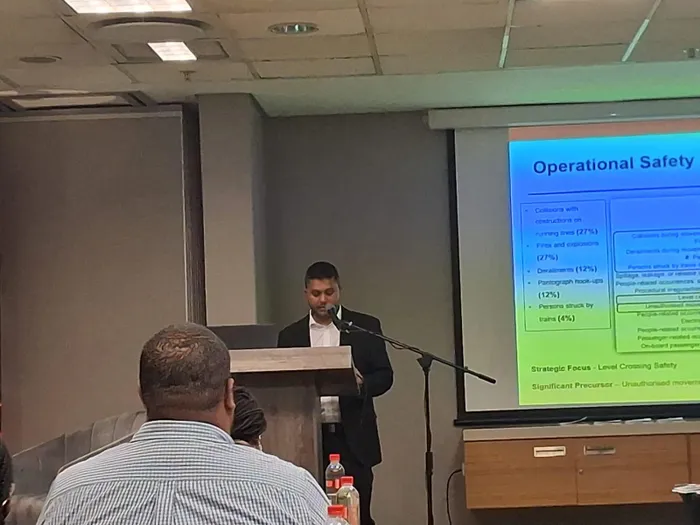Security-related rail fatalities surge sharply – RSR warns of deepening safety crisis
LOGISTICS

Deepak Budhram, Head of Safety Management at RSR, said that security-related fatalities and injuries extend well beyond the immediate boundaries of the rail environment, serving as a stark reminder of the far-reaching socio-economic challenges confronting South Africa.
Image: Yoagshen Pillay
The Railway Safety Regulator (RSR) has raised alarm over the growing number of deaths linked to crime and security incidents across South Africa’s rail network, warning that the crisis underscores the country’s broader socio-economic challenges.
According to the RSR’s State of Safety 2024/2025 report, security-related fatalities in the rail sector have risen sharply over the past five years — from 13 deaths in 2021/22 to 58 in 2024/25.
The regulator presented its findings during a roadshow in Durban on Friday, revealing that KwaZulu-Natal was the hardest-hit province.
KwaZulu-Natal recorded 2 707 railway-related occurrences, with 67% attributed to security-related incidents, the highest number of fatalities (24), and 52 injuries.
RSR’s head of safety management, Deepak Budhram, said the findings highlight how the country’s persistent crime problem spills into the rail sector, which serves as both a target and a conduit for criminal behaviour.
“While certain criminal acts are deliberately aimed at railway assets, such as the theft of infrastructure or vandalism, many security-related risks stem from broader patterns of crime,” Budhram said.
“These risks frequently spill over into the rail system, which, as a critical component of public infrastructure, becomes both a target and a conduit for criminal behaviour. The consequences are often severe, including loss of life and injury.”
The RSR’s data shows a fluctuating but worrying trend in fatalities and injuries over the last five years. Fatalities peaked at 74 in 2023/24, nearly double the five-year average of 35, before declining to 58 in 2024/25 — still significantly above historical levels.
Injuries, meanwhile, have remained relatively stable around the five-year average of 76, with a slight uptick to 83 injuries recorded in the latest financial year.
Budhram noted that the majority of fatalities were linked to human bodies discovered within the rail reserve or directly on railway tracks, suggesting ongoing safety and security challenges beyond mere operational issues.
A spatial analysis by the regulator reveals sharp regional disparities. KwaZulu-Natal remains the epicentre of security-related rail incidents, followed by Free State and Gauteng, where such cases account for 80% and 79% of total occurrences respectively.
“In contrast, provinces like Northern Cape and Eastern Cape report a more balanced or operationally skewed risk profile, suggesting different intervention priorities,” he said.
Budhram added that these spatial patterns underscore the importance of geographically targeted safety strategies that align with the unique risk profiles of each province.
“Tailored responses, which range from infrastructure upgrades and surveillance in high-theft zones to operational safety enhancements in lower-risk areas, are essential for building a safer, more resilient rail system nationwide,” said Budhram.
“The analysis further indicates that 79% of all railway occurrences in the 2024/25 FY were concentrated in just four provinces (KwaZulu-Natal, Gauteng, Mpumalanga, and Western Cape) that accounted for 85% of all fatalities and 91% of injuries linked to railway incidents nationally.”
Budhram said that KwaZulu-Natal recorded the highest number of railway-related occurrences, both operational and security-related, in the 2024/25 FY, accounting for 29% of all incidents nationally.
“Notably, over 98% of these occurrences were reported by the two largest rail operators in the province: Transnet Freight Rail and Prasa. Both entities were severely affected by the persistent and systemic theft and vandalism of critical railway assets, which directly undermined operational safety and network reliability.”
Ulrich Joubert, an independent economist, said the rising deaths and injuries reflect deeper systemic problems within South Africa’s rail infrastructure.
“First of all, the condition of the railway network and the ageing infrastructure. We come back to a situation where we say there is a problem with the maintenance. The ageing infrastructure has not been replaced or maintained properly,” Joubert said.
“One must also look at this report and say, yes, we see the physical things, but unfortunately, there is also a problem. The infrastructure on which the railway lines have been laid down on the ground, that system, the sleepers, the old wooden sleepers that haven't been replaced, some of which are rotten.”
BUSINESS REPORT